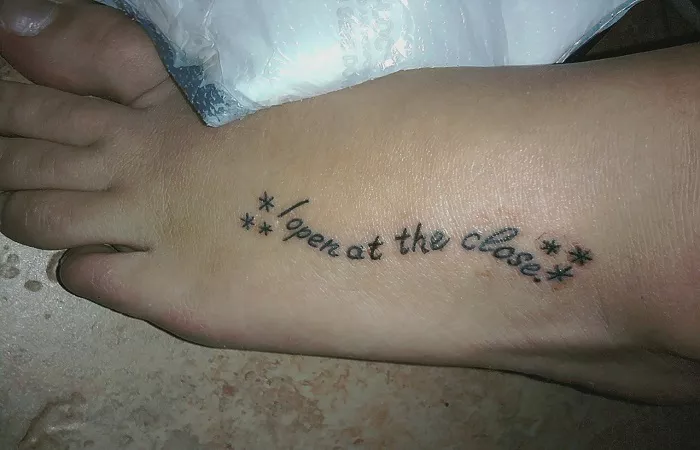Anxiety is a common mental health condition that affects millions of people worldwide. It can be a challenging emotion to cope with, and for some individuals, expressing their feelings can be difficult. One way that some people choose to express their anxiety is through tattoos. In this article, we will explore the symbolism behind anxiety tattoos, including their meaning, design, and cultural significance. We will also discuss the importance of understanding anxiety and seeking professional help when needed.
Understanding Anxiety:
Anxiety is a feeling of unease, worry, or fear that can range from mild to severe. It is a normal human emotion that can be triggered by a variety of situations, such as stress, trauma, or phobias. However, for some people, anxiety can become chronic and interfere with their daily life. Symptoms of anxiety can include racing thoughts, restlessness, difficulty concentrating, and physical symptoms such as sweating or trembling.
Symbolism of Anxiety Tattoos:
Anxiety tattoos can hold a variety of meanings and symbolism. For some people, getting an anxiety tattoo can be a way to express their struggle with anxiety and remind themselves that they are not alone. For others, an anxiety tattoo can be a symbol of their strength and resilience in the face of their anxiety. The design of an anxiety tattoo can also hold significance, with some people choosing to incorporate symbols such as butterflies, birds, or flowers to represent transformation, freedom, or growth.
Design of Anxiety Tattoos:
The design of an anxiety tattoo can vary depending on the individual and their personal experience with anxiety. Some popular designs for anxiety tattoos include:
Semi-colon: The semi-colon tattoo has become a popular symbol for mental health awareness, including anxiety. The semi-colon represents a pause in a sentence, with the sentence being the person’s life. The tattoo is a reminder to keep going and not give up.
Birds: Birds are often used in anxiety tattoos to represent freedom and the ability to overcome obstacles. The bird can be depicted in flight or perched on a branch, symbolizing the ability to rise above anxiety.
Butterflies: Butterflies are a symbol of transformation and growth, making them a popular choice for anxiety tattoos. The butterfly can be depicted in different stages of its life cycle, representing the journey of overcoming anxiety.
Flowers: Flowers are often used in anxiety tattoos to represent beauty and growth in the face of adversity. The flower can be depicted in different stages of growth, representing the journey of overcoming anxiety.
Placement of Anxiety Tattoos:
The placement of an anxiety tattoo can also hold significance. Some popular placements for anxiety tattoos include:
Wrist: Anxiety tattoos on the wrist can be a reminder to stay strong and keep going. The wrist is also a visible location for the tattoo, making it a popular choice for those who want to show off their design.
Back: Anxiety tattoos on the back can represent the weight of anxiety and the struggle to overcome it. The back is also a large canvas for the tattoo, allowing for intricate designs and details.
Chest: Anxiety tattoos on the chest can represent the heart and the emotional toll that anxiety can take. The chest is also a powerful location for the tattoo, as it is close to the heart and can symbolize deep personal beliefs.
Cultural Significance of Anxiety Tattoos:
Anxiety tattoos hold cultural significance in many different cultures. In some cultures, tattoos are used as a form of self-expression and can represent personal beliefs and struggles. In Western culture, tattoos have become more mainstream and are often used as a form of self-expression and art. In some cultures, tattoos are still associated with criminal activity or social stigma, making it important for individuals to consider the cultural significance of their anxiety tattoo.
Seeking Professional Help:
While tattoos can be a powerful way to express emotions and experiences, it is important to remember that they are not a substitute for professional help. Anxiety is a complex mental health condition that often requires the help of a qualified healthcare professional. Seeking therapy or medication can be an important step in managing anxiety and improving overall mental health.
Choosing an Anxiety Tattoo:
When choosing an anxiety tattoo, it is important to consider the symbolism and design that will hold personal meaning for you. You may want to choose a design that represents your personal journey with anxiety or a symbol that holds significance to you. It is also important to consider the placement of the tattoo and the cultural significance of the design.
Aftercare for Anxiety Tattoos:
Proper aftercare is important for any tattoo, including anxiety tattoos. It is important to follow the aftercare instructions provided by your tattoo artist to ensure that the tattoo heals properly and remains vibrant. This can include keeping the tattoo clean and moisturized, avoiding direct sunlight and excessive sweating, and avoiding scratching or picking at the tattoo.
Conclusion:
Anxiety tattoos are a unique and personal way for individuals to express their struggle with anxiety. The symbolism and design of an anxiety tattoo can hold deep personal meaning and can be a powerful reminder of the individual’s strength and resilience. The placement and cultural significance of the tattoo should also be considered when choosing a design. However, it is important to remember that tattoos are not a substitute for professional help. Seeking therapy or medication can be an important step in managing anxiety and improving overall mental health. By choosing an anxiety tattoo and seeking professional help, individuals can create a personal and meaningful expression of their individuality and beliefs while also prioritizing their mental health.
Related topics:

